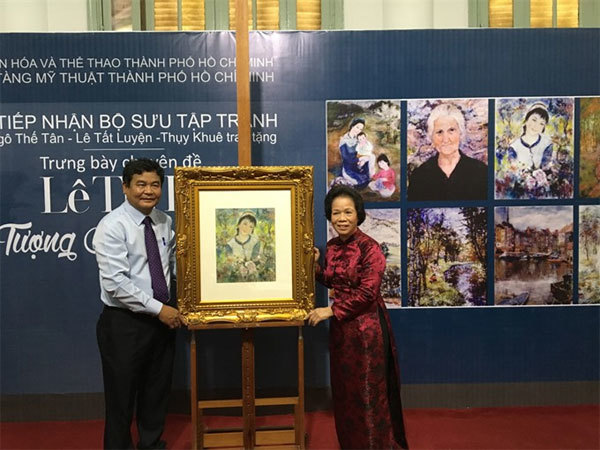Museum shows work by first female graduate of former Indochina Fine Arts College
More books needed about Vietnamese artists
Painting by Vietnamese artist sets record at auction
 |
| Collector and literary critic Thuy Khue (R) has donated paintings by female artist Le Thi Luu to the HCM City Fine Arts Museum. — VNS Photo Phuong Mai (Illustrative image) |
The reliefs are tucked away behind the houses, which sit off Tran Quoc Toan Street. The section of street is inside the Ministry of Public Security and has been inaccessible since the 1960s, hiding the sculptures from public view.
Doctor of physics Pham Long, an independent art researcher, is calling for help to restore, preserve and display the precious works, made by professors and students of the first and the second courses of the university about a century ago.
"Relevant agencies should urgently take actions to protect the bas-reliefs," Long said. "They are part of the precious heritage of modern Vietnamese fine arts in the early period. The public should have the chance to see them."
The predecessor of Viet Nam Fine Arts University was the Indochina Fine Arts College, located at the intersection of Tran Quoc Toan and Yet Kieu Street.
About three or four years ago, Le Van Suu, director of the fine arts university, stumbled upon the reliefs by accident and was surprised to see they were mostly intact and their original colours had been preserved.
Suu said they have great historical and artistic value, especially because he has never seen any as large in Hanoi.
"As soon as I saw the bas-reliefs I sent a letter to the ministry asking for permission to come in and cast them," he said. "But I didn't get a response."
"And now, it is not our jurisdiction," Suu said. "We can only propose the ministry and city authorities protect the reliefs from damage. And it is possible to open this space for the public to see."
Many experts and artists have said they regret that the reliefs have been hidden from view for decades, depriving the public of their beauty.
In order to preserve the reliefs they should be kept at the place where they were made, according to veteran artist Huy Oanh, former deputy director of the university and former chairman of Viet Nam Fine Arts Association's Art Council.
He was once a student at the university. He remembers a time when he and his friends exercised on Tran Quoc Toan Street, jogging past the reliefs.
"At that time, it was very rare to make a bas-relief," Oanh said. "The reliefs were created by sculptor Vu Cao Dam and his two counterparts under the guidance of French professors.
"The reliefs have a compact composition. The sculpted materials raised above the background plane are harmonious and well proportioned."
According to a document by French artist Victor Tardieu, one of the founders of the Indochina Fine Arts College, the reliefs were sent to an exhibition in Paris in 1931. They measured 39m by 2m.
The old works show the impact of the Indochina Fine Arts College. They are associated with the birth of the Viet Nam Fine Arts University. The preservation of this valuable heritage is an urgent requirement, according to artist Nguyen Trong Cat.
Ninety-two-year-old Associate Professor Cat, a former lecturer at the university, said that he studied there in 1946. As a result he is particularly interested in their history.
"Georges Khanh was the first sculpture course graduate to sketch the bas-reliefs with the theme of coastal fishermen," artist Cat said. "This was a collective project of the first course students under the guidance of French lecturers such as Tardieu, Évariste Jonchère and Joseph Ingumimberty."
Cat is familiar with the history of the reliefs because he heard about it from his teachers such as masters Luong Xuan Nhi and Tran Van Can.
Another witness to the creation of the works is artist Nguyen Van Chung, also a former lecturer at the university.
The row of houses was built in 1925 as a part of the Indochina Fine Arts College with the back doors opening to Tran Quoc Toan Street. According to Chung, the huge reliefs were brought out through the back door of the college and mounted on the wall of the block of houses.
"The section of Tran Quoc Toan Street needs to be reopened so the public can directly see the precious and rare sculptures made during the first period of Vietnamese modern fine arts," Chung said.
"These bas-reliefs are symbols of Vietnamese modern fine art in the early period because they are very rare sculptures created during the formation and development of the Indochina Fine Arts College. The number of sculptors trained in this period is tiny."
Artists and researchers at home and abroad have commented on the reliefs and are also discussing reaching out to authorities to recommend methods to preserve them.
"The plan to preserve the bas-reliefs is the best because it can keep them and the remaining houses of the Indochina Fine Arts College – unique architecture and painting workshops from the late 1920s and early 1930s," Long said.
He also suggests the Ministry of Culture, Sports and Tourism set up a council to evaluate the value of the reliefs and consider recognising them as national relics in accordance with the Cultural Heritage Law. VNS
Nguyen Binh
 Hanoi's artists, from the past to the present, have long talked about two giant bas-reliefs on a wall hidden behind a row of houses at the Viet Nam Fine Arts University.
Hanoi's artists, from the past to the present, have long talked about two giant bas-reliefs on a wall hidden behind a row of houses at the Viet Nam Fine Arts University.